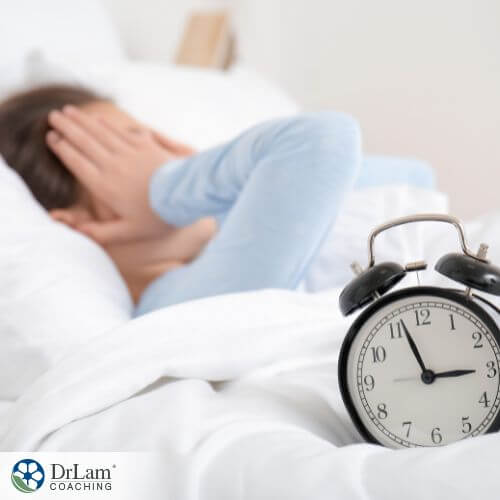 Some people are happy to get a second wind, suddenly finding they have more energy to complete a task or stay awake longer. However, if you have had a long day and simply need quality sleep, a second wind could be a problem for you. It could keep you up late at night rob your body of much-needed rest, and prevent it from doing its job to repair and rebalance your body’s cortisol levels after a stressful day. A second wind can be even more problematic if you suffer from adrenal fatigue, for which adequate sleep is a must to help ease symptoms. Good quality sleep is essential for adrenal fatigue recovery, and maintaining a suitable sleeping schedule will help your adrenals get stronger and your body repair and recharge after excess depletion. Learn more about a second wind sleep and how it can impact adrenal fatigue.
Some people are happy to get a second wind, suddenly finding they have more energy to complete a task or stay awake longer. However, if you have had a long day and simply need quality sleep, a second wind could be a problem for you. It could keep you up late at night rob your body of much-needed rest, and prevent it from doing its job to repair and rebalance your body’s cortisol levels after a stressful day. A second wind can be even more problematic if you suffer from adrenal fatigue, for which adequate sleep is a must to help ease symptoms. Good quality sleep is essential for adrenal fatigue recovery, and maintaining a suitable sleeping schedule will help your adrenals get stronger and your body repair and recharge after excess depletion. Learn more about a second wind sleep and how it can impact adrenal fatigue.
Getting a second wind generally refers to a burst of energy that you experience well after you have used up your initial energy reserves. In the context of your sleep schedule, this phenomenon refers to an experience where you feel drowsy early in the evening, but you have a burst of energy after that first period of sleepiness subsides. You get more energy in the late afternoon to night time, even though before that you were tired. Sometimes this renewed energy can keep you from falling asleep.
Particular factors may make you more likely to experience a nighttime jump in energy. These include:
The unique makeup of your circadian rhythm, which is the 24-hour internal clock that impacts your sleep-wake cycle, may be more likely to lead to a second wind of alertness near your winding down time.
Your circadian rhythm functions with the release of cortisol, which promotes wakefulness during the day, and melatonin, which promotes sleepiness at nighttime. Yet each person’s circadian rhythm pattern can be a little different.
For instance, according to sleep experts, most people may sleep between 10 a.m. and 6 p.m., or 11 p.m. and 7 a.m. However, some people are biologically wired with more energy in the evenings, which is when they are more likely to do their best work. In this case, it’s later into the night that your brain releases sleep-promoting melatonin. If this sounds like you, it may increase your chance of a second wind sleep at night.
 Working concurrently with your circadian rhythm throughout the day is your homeostatic sleep drive, which is essentially your appetite for sleep. Your homeostatic sleep drive is impacted by your body’s production of the chemical adenosine, which is affected by your behaviors. For example, exercise can cause your body’s cells to break down adenosine triphosphate (ATP) in the brain for fuel. When this happens, you are left with more adenosine, which helps to increase your appetite for sleep, and according to an article in the journal Frontiers in Pharmacology, plays a role in controlling sleep.
Working concurrently with your circadian rhythm throughout the day is your homeostatic sleep drive, which is essentially your appetite for sleep. Your homeostatic sleep drive is impacted by your body’s production of the chemical adenosine, which is affected by your behaviors. For example, exercise can cause your body’s cells to break down adenosine triphosphate (ATP) in the brain for fuel. When this happens, you are left with more adenosine, which helps to increase your appetite for sleep, and according to an article in the journal Frontiers in Pharmacology, plays a role in controlling sleep.
However, certain behaviors can also reduce your sleep drive and leave you experiencing a second wind at night. For example, consuming caffeine in the afternoon or evening can block the activity of the chemical that sends a signal to your brain that it's time to sleep. In this case, caffeine is an antagonist of adenosine, and it could cause you to feel wired rather than tired before bedtime.
A second wind may come about as a result of your cumulative sleep debt. Typically, if you are awake for longer, you get less sleep, and you tend to feel more tired. Also, you increase the chance of your brain building up chemicals like adenosine that can get you back to sleep.
However, when you accumulate extensive sleep deprivation, the opposite effect can occur. When you dedicate less and less time to sleep, your body goes into "fight or flight" mode, triggering the release of the hormone adrenaline. This, paradoxically, gives you the feeling of increased alertness just when you want and perhaps need to sleep.
Chronic stress and elevated cortisol levels, which go hand in hand with adrenal fatigue, can make you more vulnerable to symptoms that make it hard to get to sleep.
Adrenal Fatigue Syndrome (AFS), is the non-Addison's form of adrenal dysfunction, where the body's stress response cannot keep up with life's chronic stressors. During AFS, your body is severely overstressed, and as chronic fatigue sets in, your body enters survival mode to conserve energy. Symptoms of AFS include being unable to fall asleep despite being tired and feeling wired and unable to relax. A second wind can disrupt much-needed sleep especially when you have adrenal fatigue.
Cortisol levels and cycles can be severely disrupted if you have AFS or any form of dysregulation in your NeuroEndoMetabolic (NEM) Stress Response. At first, cortisol, the “stress hormone”, increases to meet the growing demand, which is when a cortisol second wind is more likely to occur. However, it eventually declines completely, when your adrenals are exhausted and can no longer function.
The Neuroaffect circuit, one of the six circuits of the NEM Stress Response model helps to neutralize stress and keep our body operating optimally. It comprises the brain, autonomic nervous system, and the microbiome. Cortisol and adrenaline production boosts autonomic nervous system (ANS) activity during AFS in response to the body’s stress levels. ANS triggers the fight-or-flight response, which creates a burst of energy that can cause a second wind.
 Two types of sleep disturbances are common in AFS, one, sleep onset insomnia, where it is difficult to fall asleep in the first place, and two, sleep maintenance insomnia, where you do fall asleep but have a hard time staying asleep.
Two types of sleep disturbances are common in AFS, one, sleep onset insomnia, where it is difficult to fall asleep in the first place, and two, sleep maintenance insomnia, where you do fall asleep but have a hard time staying asleep.
It’s common for those suffering from AFS to wake up in the middle of the night, usually around 2:00 a.m. and 3:00 a.m., and then have difficulty falling back asleep. Also, many people with adrenal fatigue experience relative hypoglycemia during the night, which can wake them up.
Additionally, your adrenals kick in for a second wind between 11:00 p.m. and 1:00 a.m. You may have noticed that, if you don’t go to bed by 10:00 p.m. when it’s the optimal time for people to go to sleep, you pass through the sleepiness phase only to then feel more awake afterward. By the time this second wind kicks in, it might be difficult to fall asleep at all until it’s over, at around 1:00 a.m.
This is especially the case if you’re in the earlier stages of AFS when your adrenals are still able to produce the high levels of cortisol being demanded in order to cope with the chronic stress your body is facing.
Another type of second wind that happens to those with adrenal fatigue is the afternoon surge that could last till the evening, keeping you awake even though you have no energy. This can also show up as feeling wired and tired all day long, and yet when it comes to bedtime, even though you’re sleepy at 9:00 or 10:00 p.m., you still resist going to bed.
Both of these types of second wind can be avoided by maintaining a very strict bedtime schedule, and always going to bed at (or slightly before) 10:00 p.m. Doing this, along with a few other sleep hygiene techniques, will give you a much better chance at getting a full night’s rest.
And, finally, the normal surge in cortisol levels in the morning can sometimes come a little earlier than usual, waking you up prematurely. For all adrenal fatigue sufferers, we recommend bypassing this type of cortisol surge, whether it comes earlier than it should or if it comes during the regular window between 6:00 and 8:00 a.m., by trying to sleep in until 8:30 or 9:00 a.m.
There are several other ways to address second wind sleep issues as well. These include:
Deep, slow breathing is a helpful practice for those dealing with stress, AFS, and sleep issues. An article in the Journal of Medical and Dental Science, deep breathing stimulates a relaxation response, reduces inflammation, and can enhance your cardiovascular and immune system.
As such, deep breathing exercises can help to ameliorate AFS symptoms, such as fatigue, insomnia, depression, and the inability to manage stress by shutting off the body’s fight-or-flight response.
You can do these exercises by sitting or laying down somewhere quiet and breathing in slowly, in a relaxed manner, filling your lower lungs with air, and then filling your upper lungs. Exhale slowly, relaxing the muscles in your shoulders, neck, and face. Repeat ten times.
Yoga comprises various poses and postures. It can enhance your balance, flexibility, and strength, reduce stress levels, and may help with “second-wind” sleep issues. You’ll get both a physical and mental boost from practicing yoga.
The mind-body restoration yoga sequence of poses is crucial for connecting the mind and body. As such, yoga increases blood flow to your adrenals and stimulates the nervous system to switch to calmness and allow deep inner healing to occur. Some of the gentlest yoga poses for adrenal recovery include Child’s Pose (Balasana), Corpse Pose (Savasana), and Easy Pose (Sukhasana). However, talk with your doctor before starting any exercises if you have AFS or other health conditions.
 When your body experiences continuous stress, it’s unable to effectively regulate its parasympathetic nervous system (PNS). This makes recovery extremely difficult. It’s important to reduce stress levels and reduce adrenaline secretion. This will help to restore the hypothalamic-pituitary-adrenal axis (HPA) to normal function.
When your body experiences continuous stress, it’s unable to effectively regulate its parasympathetic nervous system (PNS). This makes recovery extremely difficult. It’s important to reduce stress levels and reduce adrenaline secretion. This will help to restore the hypothalamic-pituitary-adrenal axis (HPA) to normal function.
According to an article in Frontiers in Behavioral Neuroscience, the PNS should be restored so that your body relaxes, the remaining adrenaline is metabolized, and your body heals from the effects of stress. Mild exercise, yoga, meditation, and deep breathing can help you to decompress and reinforce your PNS.
Many herbs and supplements contain natural substances that support different functions in the body and may help calm your system.
Ashwagandha is a herb that has long been used for stress, acting as a balancer that calms your nervous systems, minimizes daytime fatigue and cortisol levels, fights depression, and promotes nighttime sleep. Other herbs such as lemon balm, holy basil, or chamomile may help as well.
Additionally, Dr Lam’s Adrenal PS and Adrenal Calm supplements can also provide calming effects. Adrenal PS provides your body with phosphorylated serine as well as other minerals. It facilitates stress management, helps to modulate your cortisol levels, and increases your stress resilience.
Dr Lam’s Adrenal Calm is a soothing blend of of vitamins, herbs, and amino acids that support the down-regulation of overstimulated nerve cells and help calm the mind and body. It contains GABA, which can help to promote relaxation and balance mood.
Good quality sleep is essential for adrenal fatigue recovery. Maintaining an appropriate sleeping schedule is an important part of an overall sleep hygiene routine that will help your adrenals strengthen and heal and your body repair and recharge.
Your stress and cortisol levels can cause a second wind at a bad time, making it hard to sleep. Taking steps to lower stress is important here. To do this, focus on acquiring the tools and medical support you need to help manage your stressors and practice more relaxation in your life. Some supplements may help as well. If you have adrenal fatigue and would like further sleep tips, give our team a call to help you on this journey.
Alaguveni, T., and Devaki P. R. "Effect of Deep Breathing Exercise on Heart Rate Variability of Different Age Groups." Journal of Research in Medical and Dental Science, vol. 9, no. 4, 2021, pp. 267-275, https://www.jrmds.in/articles/effect-of-deep-breathing-exercise-on-heart-rate-variability-of-different-age-groups-70226.html
Sheng, Julietta A., et al. "The Hypothalamic-Pituitary-Adrenal Axis: Development, Programming Actions of Hormones, and Maternal-Fetal Interactions." Frontiers in Behavioral Neuroscience, vol. 14, 2021, article 601939, https://doi.org/10.3389/fnbeh.2020.601939.
Garcia-Gil, Mercedes, et al. “Metabolic Aspect of Adenosine Functions in the Brain.” Frontiers in Pharmacology, vol. 12, 2021, article 672182, https://doi.org/10.3389/fphar.2021.672182.
Getting a second wind can disrupt your sleep and worsen adrenal fatigue symptoms. It can interfere with your circadian rhythm, impact your cortisol levels, and have you feeling wired and more alert rather than sleepy. Essentially, when you should be sleeping, you are up and full of energy, even though you are tired.
